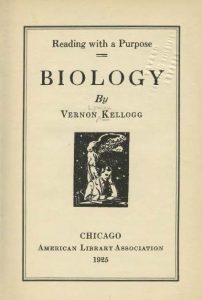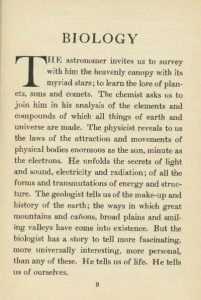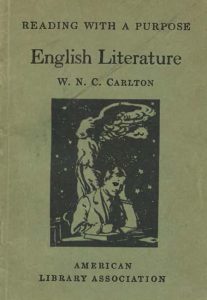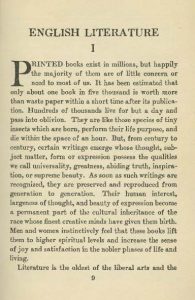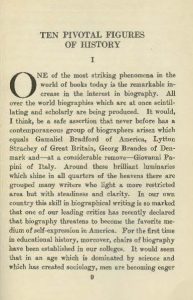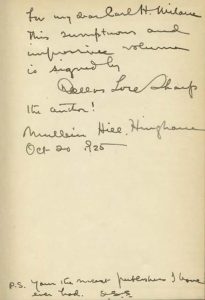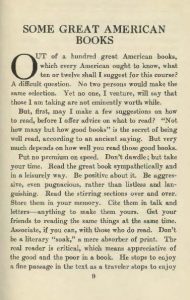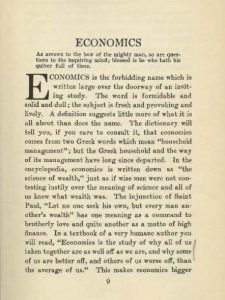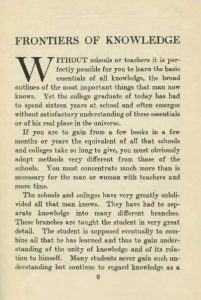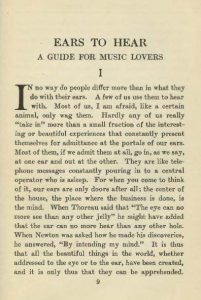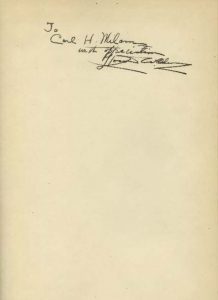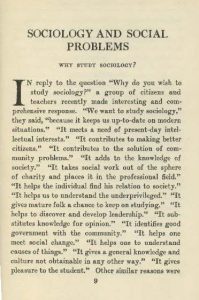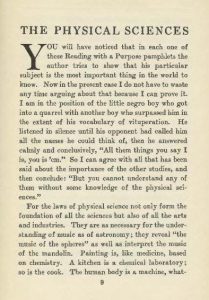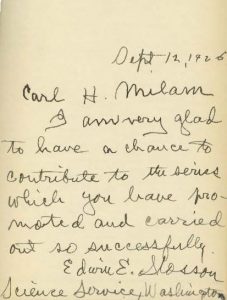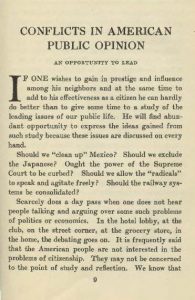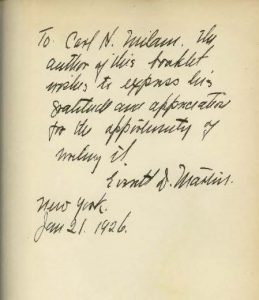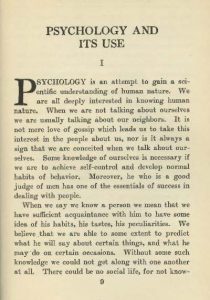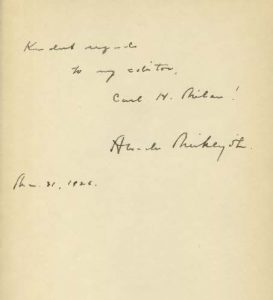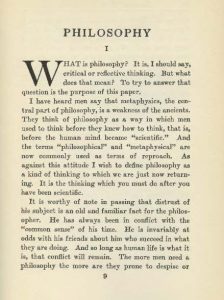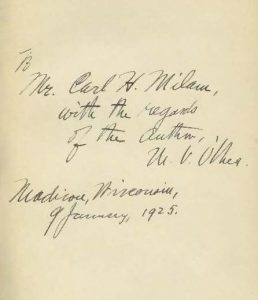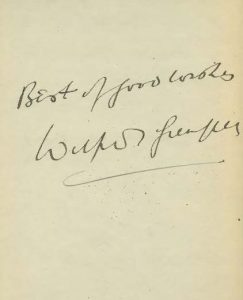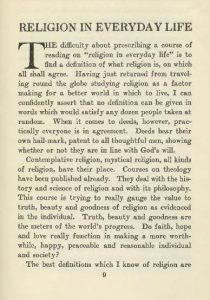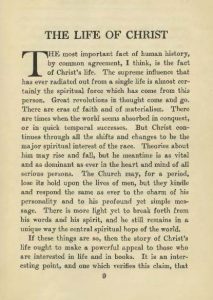From 1925 through 1933, known under the series title Reading with a Purpose, the American Library Association produced a series of resources to support general reading on a variety of topics, for adult readers who completed formal schooling. Each publication is rich in the perspectives of scholarly authorities of its time. Read on to learn more about Reading with a Purpose!
In the first book, Biology, by U.S. entomologist Dr. Vernon Lyman Kellogg, the author introduces biology from the perspective of an evolutionary biologist. While English Literature, by librarian William Newnham Chattin Carlton, introduces literature from the perspective of an English immigrant working in the U.S.
In the images above, we see a sample cover page, a book cover, and the first page of each book. On the cover of each book, the Reading with a Purpose Series book covers feature a foregrounded man reading a book with the figure of victory, Nike, standing behind the reader. This image is found on paperbound book covers and on the title page of almost every book. Inside of each book, there is also a one-page statement about the book’s purpose, and it is followed by a one-page biography of the author too.
Ten Pivotal Figures of History, by Carleton College Biography Professor Ambrose W. Vernon, provides biographies of 10 influential men from European and U.S. history. While Some Great American Books, by naturalist and English professor (and also former librarian) Dallas Lore Sharp, recommends 12 major works of American literature.
Unique the the A.L.A. Archives’ holdings, many books from the series include dedications to A.L.A. Secretary (1920-1948) Carl H. Milam (Record Series 2/4/25) and the American Library Association. Beyond providing an amusing collection of signatures of writers, in this record series and others, researchers may benefit from examining book dedications, for additional contextual information about the authors or the authors’ relationships with either their audience or their publishers.
Economics, by law professor and economist Dr. Walton Hale Hamilton, invites readers to the study of economics in this guide to 6 key books. Frontiers of Knowledge, by journalist and newspaper editorial writer Jesse Lee Bennett, introduces readers to 10 books concerning the development of knowledge from different fields of study. While Ears to Hear: A Guide for Music Lovers, by U.S. music composer and music critic Daniel Gregory Mason, introduces readers to music appreciation through a deeper appreciation of it.
In the images above, we see the first page of each installment book, to appreciate both the wide-range of reading topics as well as the different writing styles of each writer too. All three of these books have not been inscribed.
Sociology and Social Problems, by U.S. sociologist Dr. Howard Washington Odum, introduces the field of study and guides readers to 7 key sociological works. While in The Physical Sciences, by chemist and journalist Dr. Edwin Emery Slosson, introduces readers to physical sciences research.
In the images above, we see two different samples of book inscriptions from authors. While Dr. Odum signs his name, Dr. Slosson includes a note acknowledging his appreciation to contribute in this A.L.A. publication project to support the promotion of informed reading to the American public. In these 2 inscriptions, readers can appreciate the wide differences between authors who sign their names and authors who choose to include personal notes. From Dr. Slosson’s note, we learn that he was “very glad” to be a part of this ALA initiative and he viewed the project as successful.
In Conflicts in American Public Opinion, by newspaper editors William Allen White and Walter E. Myer, the authors introduce readers to current issues in U.S. public policies and guide readers to 6 key books for further reading. While in Psychology and Its Use, by social psychologist Everett Dean Martin, the author introduces readers to the field of psychology and guides readers to 7 key books for further reading.
In Philosophy, by philosopher and university administrator, Dr. Alexander Meiklejohn, the author describes philosophical thinking and encourages readers to practice philosophy through both reading and thinking through issues. In Our Children, by childhood and youth researcher, Michael Vincent O’Shea, the author describes the complexities inherent to studying childhood and youth, before guiding readers to 6 recent books on childhood and youth.
In Religion in Everyday Life, by Newfoundland medical missionary and writer, Sir Wilfred Thomason Grenfell, the author introduces examples of religious philosophy in everyday life, with emphasis on Christianity and Christian philosophical writings. While in The Life of Christ, by U.S. Quaker historian, philosopher, and theologian Rufus M. Jones, the author introduces readers to different studies of the life of Jesus.
From the sciences to the arts and humanities, the Reading with a Purpose Series was published from 1925 through 1933, with the goal of providing recommended reading on a variety of topics to support the lifelong learning of adults. In this sample of some publications from the series, readers can see both the breadth of topics and the authors’ writing styles, as well as how special collections, like archives, can hold unique samples of ephemeral information like personal inscriptions rich with personal information about the writers and their readers.
Copies Available at Your ALA Archives
Physical copies of Reading with a Purpose are available for viewing at the ALA Archives. Please view the Record Series 29/3/10 database record entry, for more information.
Got Something to Donate to the Story So Far?
Many people have been involved in the long history of A.L.A. publications and bibliographic work. Do you have any information about Reading with a Purpose participants, collaborators, publications, or beneficiaries? Please contact us through social media. We and our readers would like to read about it.
